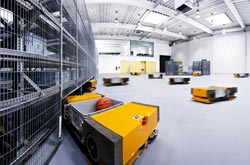Swarming and transporting

The autonomous transporters perform their work in a swarm. © Fraunhofer IML<br>
The orange-colored vehicle begins moving with a quiet whirr. Soon afterwards the next shuttles begin to move, and before long there are dozens of mini-transporters rolling around in the hall. As if by magic, they head for the high-rack storage shelves or spin around their own axis.
But the Multishuttle Moves® – is the name given to these driverless transport vehicles – are not performing some robots‘ ballet. They are moving around in the service of science. At the Fraunhofer Institute for Material Flow and Logistics IML in Dortmund, Germany, researchers are working to harness swarm intelligence as a means of improving the flow of materials and goods in the warehouse environment. In a research hall 1000 square meters in size, the scientists have replicated a small-scale distribution warehouse with storage shelves for 600 small-part carriers and eight picking stations.
The heart of the testing facility is a swarm of 50 autonomous vehicles. “In the future, transport systems should be able to perform all of these tasks autonomously, from removal from storage at the shelf to delivery to a picking station. This will provide an alternative to conventional materials-handling solutions,“ explains Prof. Dr. Michael ten Hompel, executive director at IML.
But how do the vehicles know what they should transport, and where, and which of the 50 shuttles will take on any particular order? “The driverless transport vehicles are locally controlled. The ›intelligence‹ is in the transporters themselves,“ Dipl.-Ing. Thomas Albrecht, head of the Autonomous Transport Systems department explains the researchers‘ solution approach. “We rely on agent-based software and use ant algorithms based on the work of Marco Dorigo. These are methods of combinational optimization based on the model behavior of real ants in their search for food.“ When an order is received, the shuttles are informed of this through a software agent. They then coordinate with one another via WLAN to determine which shuttle can take over the load. The job goes to whichever free transport system is closest.
The shuttles are completely unimpeded as they navigate throughout the space – with no guidelines. Their integrated localization and navigation technology make this possible. The vehicles have a newly developed, hybrid sensor concept with signal-based location capability, distance and acceleration sensors and laser scanners. This way, the vehicles can compute the shortest route to any destination. The sensors also help prevent collisions.
The vehicles are based on the components of the shelf-bound Multishuttle already successfully in use for several years. The researchers at IML have worked with colleagues at Dematic to develop the system further. The special feature about the Multishuttle Move®: the transporters can navigate in the storage area and in the hall. To accomplish this, the shuttles are fitted with an additional floor running gear. But what benefits do these autonomous transporters offer compared with conventional steady materials-handling technology with roller tracks? “The system is considerably more flexible and scalable,“ Albrecht points out. It can grow or contract depending on the needs at hand. This is how system performance can be adapted to seasonal and daily fluctuation. Another benefit: It considerably shortens transportation paths. In conventional storage facilities, materials-handling equipment obstructs the area between high-rack storage and picking stations.
Packages must travel two to three times farther than the direct route. “It also makes shelf-control units and steady materials-handling technology,“ Albrecht adds. Researchers are now trying to determine how these autonomous transporters can improve intralogistics. “We want to demonstrate that cellular materials-handling technology makes sense not only technically but also economically as an alternative to classic materials-handling technology and shelf-control units,“ institute executive director ten Hompel observes. If this succeeds, the autonomous vehicles could soon be going into service in warehouses.
Media Contact
All latest news from the category: Transportation and Logistics
This field deals with all spatial and time-related activities involved in bridging the gap between goods and people, including their restructuring. This begins with the supplier and follows each stage of the operational value chain to product delivery and concludes with product disposal and recycling.
innovations-report provides informative reports and articles on such topics as traffic telematics, toll collection, traffic management systems, route planning, high-speed rail (Transrapid), traffic infrastructures, air safety, transport technologies, transport logistics, production logistics and mobility.
Newest articles

Silicon Carbide Innovation Alliance to drive industrial-scale semiconductor work
Known for its ability to withstand extreme environments and high voltages, silicon carbide (SiC) is a semiconducting material made up of silicon and carbon atoms arranged into crystals that is…

New SPECT/CT technique shows impressive biomarker identification
…offers increased access for prostate cancer patients. A novel SPECT/CT acquisition method can accurately detect radiopharmaceutical biodistribution in a convenient manner for prostate cancer patients, opening the door for more…

How 3D printers can give robots a soft touch
Soft skin coverings and touch sensors have emerged as a promising feature for robots that are both safer and more intuitive for human interaction, but they are expensive and difficult…





















